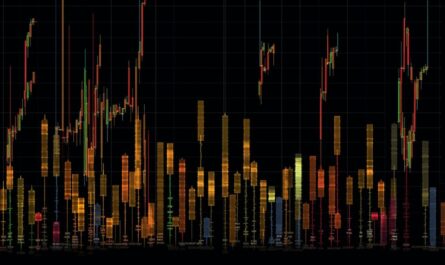Yield farming coins have become a cornerstone of the decentralized finance (DeFi) ecosystem, offering lucrative rewards for investors and driving the growth of the broader cryptocurrency market. This article explores the phenomenon of yield farming coins, their relationship to DeFi, and their impact on crypto trading. As the DeFi landscape continues to evolve, understanding the intricacies of yield farming coins is vital for both investors and industry professionals.
I. Yield Farming Coins: A Brief Overview
A. Defining Yield Farming
Yield farming, also known as liquidity mining, is a method of earning rewards by staking or lending digital assets on decentralized platforms [1]. Users can earn a share of the platform’s fees, interest, or governance tokens as a reward for contributing to the network’s liquidity.
[1] T. Chen, Z. Li, Y. Zhang, J. Li, Z. Zheng, X. Luo, J. Wu, Y. Zhang, “A First Look at DeFi Yield Farming: An Empirical Study,” arXiv, March 2021, https://arxiv.org/pdf/2103.13301.pdf
B. Key Components of Yield Farming Coins
- Governance tokens
- Liquidity pools
- Automated market makers (AMMs)
- Decentralized exchanges (DEXs)
II. The Relationship Between Yield Farming Coins and DeFi
A. The Role of Yield Farming in DeFi
Yield farming coins play a critical role in the DeFi ecosystem, driving liquidity and incentivizing user participation. By providing financial incentives for users to stake or lend their assets, yield farming platforms help create a decentralized marketplace for trading, lending, and borrowing cryptocurrencies. This fosters innovation and competition within the DeFi space, as more platforms emerge to meet the growing demand for decentralized financial services.
B. The Growth of DeFi and the Yield Farming Boom
Since the inception of DeFi, the total value locked (TVL) in these platforms has grown exponentially. As of September 2021, the TVL in DeFi surpassed $80 billion. Yield farming coins have been a significant driver of this growth, as more investors seek to maximize their returns in the rapidly expanding DeFi landscape.
III. Impact of Yield Farming Coins on Crypto Trading
A. Enhanced Liquidity in Decentralized Exchanges
Yield farming coins contribute to enhanced liquidity in DEXs, as users provide assets to liquidity pools in exchange for rewards. This increased liquidity reduces slippage and facilitates more efficient price discovery, thereby attracting more users to DEXs and boosting overall trading volumes.
B. Price Volatility and Market Dynamics
The introduction of yield farming coins has also led to increased price volatility in the cryptocurrency market. This is primarily due to the high yields offered by some platforms, which can lead to sudden influxes of capital and rapid price fluctuations. Additionally, governance token rewards may cause investors to frequently move their assets between platforms in search of the best returns, further contributing to market volatility.
C. The Emergence of New Financial Instruments
Yield farming coins have spurred the development of innovative financial instruments in the DeFi space, such as liquidity pool tokens, index tokens, and derivatives. These instruments enable investors to diversify their portfolios and hedge against risk while still participating in the yield farming ecosystem.
IV. Notable Yield Farming Coins and Platforms
A. Major Yield Farming Coins
- Compound (COMP)
- Aave (AAVE)
- Yearn.Finance (YFI)
- Uniswap (UNI)
- SushiSwap (SUSHI)
B. Popular Yield Farming Platforms
- Curve Finance
- Balancer
- Bancor
- Synthetix
- MakerDAO
V. Risks and Challenges Associated with Yield Farming Coins
A. Smart Contract Vulnerabilities
One of the primary risks associated with yield farming coins is the potential for smart contract vulnerabilities [2]. As many DeFi platforms rely on complex smart contracts, they may be susceptible to hacks or exploits, potentially leading to the loss of user funds.
[2] P. Daian, S. Goldfeder, T. Kell, Y. Li, X. Zhao, I. Bentov, L. Breidenbach, and A. Juels, “Flash Boys 2.0: Frontrunning, Transaction Reordering, and Consensus Instability in Decentralized Exchanges,” IEEE Symposium on Security and Privacy, May 2020, https://ieeexplore.ieee.org/document/9152737
B. Regulatory Uncertainty
The rapid growth of yield farming coins and DeFi platforms has attracted the attention of regulators worldwide. As the regulatory landscape continues to evolve, there is a degree of uncertainty surrounding the future of yield farming coins and their classification under existing financial regulations. This uncertainty may pose challenges for the industry as it seeks to maintain compliance while fostering innovation.
C. Impermanent Loss
Impermanent loss is a risk associated with providing liquidity to AMMs, which can occur when the price of the assets in a liquidity pool changes significantly. In some cases, the rewards earned through yield farming may not be sufficient to offset the losses incurred due to impermanent loss.
VI. The Future of Yield Farming Coins and DeFi
A. Continued Innovation and Growth
As the DeFi landscape matures, it is expected that yield farming coins and platforms will continue to innovate and expand their offerings. This may include the development of new financial instruments, improved user interfaces, and enhanced security measures to protect user assets.
B. Integration with Traditional Finance
The growth of yield farming coins and DeFi platforms has the potential to reshape the global financial system by bridging the gap between traditional finance and decentralized alternatives. As DeFi gains mainstream adoption, it is likely that yield farming coins will play an increasingly important role in this ongoing transformation.
Conclusion
Yield farming coins have become an integral part of the DeFi ecosystem, driving growth and innovation within the broader cryptocurrency market. As the industry continues to evolve, understanding the intricacies of yield farming coins will be crucial for investors and industry professionals alike. Despite the risks and challenges associated with yield farming coins, their potential to revolutionize the world of finance cannot be understated. As DeFi platforms and yield farming coins mature, they have the potential to significantly disrupt traditional financial systems and pave the way for a more decentralized, accessible, and transparent global economy.
FAQs
What’s yield farming in the crypto world?
Ah, yield farming! It’s like putting your crypto to work. You stake or lend assets in a protocol to earn rewards. Think of it as the DeFi way of earning interest.
How do yield farming coins relate to DeFi?
Well, DeFi (Decentralized Finance) is the big picture here. Yield farming is just a strategy within DeFi, where coins/tokens are earned for staking or lending. They’re peas in a pod, really!
Why are traders so interested in yield farming coins?
Simple: profits. By staking or lending, traders can earn passive rewards. Plus, if the farmed tokens appreciate, that’s a double win. Moonshot potential, ya know?
Does yield farming have high risks?
Oh, for sure! Remember the mantra: “High risk, high reward.” Impermanent loss, smart contract bugs, rug pulls… always DYOR (Do Your Own Research) before diving in.
What’s “impermanent loss” you mentioned?
Ah, this one’s tricky! When you provide liquidity and the relative price of your tokens changes, you might end up with less than if you just HODLed. It’s a DeFi gotcha we all watch out for.
How do APY and APR differ in yield farming?
Great question! APY (Annual Percentage Yield) considers compound interest, while APR (Annual Percentage Rate) doesn’t. In yield farming, high APY can be super tempting, but remember, it can also be a siren call to risks.
What’s this “rug pull” danger I hear about?
Oof, rug pulls are when devs drain the liquidity pool and disappear. You’re left with worthless tokens. Like pulling the rug from under ya, hence the name. Always check project’s legitimacy!
How can I find promising yield farming opportunities?
Hop onto DeFi Pulse or yield farming aggregators. But don’t just chase the highest APY. Look at the project’s fundamentals, community, and audit status. No shortcuts in the crypto world!
Can I yield farm with any crypto?
Not exactly. Platforms usually have specific pools or pairs. Ethereum and stablecoins are common, but ecosystems like BSC or Polkadot offer different options. Always match your assets with the right farm!
What are gas fees in farming?
Gas fees are the costs you pay to Ethereum miners for transactions. When you stake, unstake, or harvest rewards, you’ll face these. Sometimes they’re high, so factor ’em into your farming calculus!
Are there any “no-loss” yield farming methods?
In theory, some pools offer “no-loss” farming, where you stake stablecoins and only rewards carry potential losses. But in crypto, there’s no free lunch. Always stay sharp and read the fine print!
Can yield farming make me a crypto millionaire?
Dream big! But remember, it’s not a guaranteed ticket to Lambo Land. Some have made it big, but others have faced losses. Diversify, stay informed, and never invest more than you can afford to lose.




